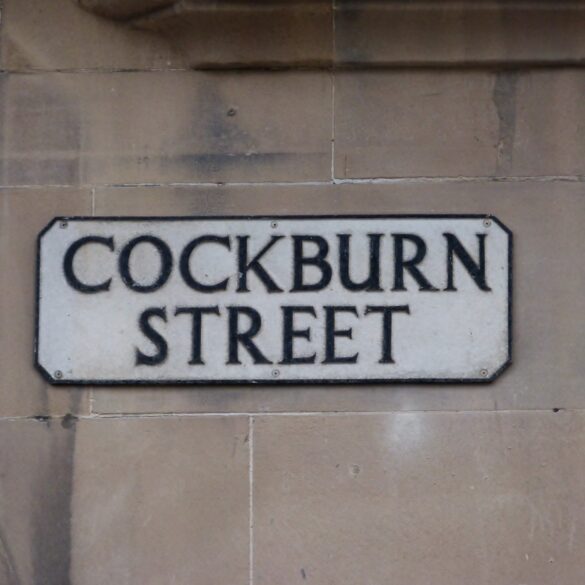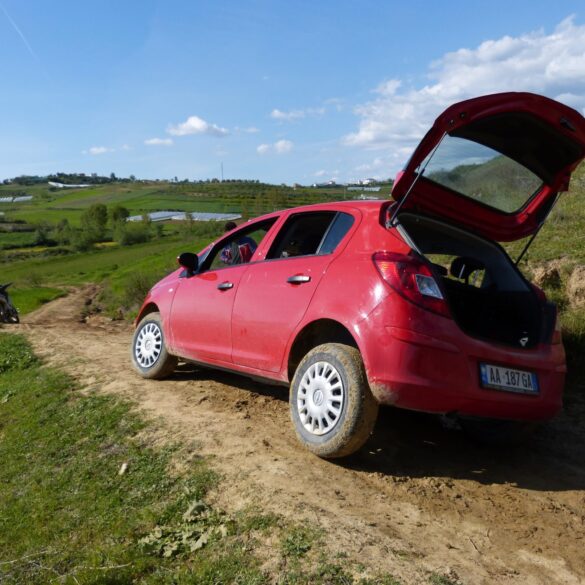While I was looking for some information about the Brothers Grimm for our visit to http://lyonsloco.blogspot.de/2014/02/the-brothers-grimm-childhood-home.html Steinau an der Straße, I came across a map that had several towns highlighted.
One of them was Gelnhausen, although I’m not quite sure what the relation is between the town and the Brothers Grimm. In any case, we spent several hours there the first Saturday in April.
The tourist information center had a great walking tour brochure, in English, with 36 sights to visit. We managed to see 35 of them. The only one we didn’t get to was a section of the old city wall but eh, we’ve seen enough of them in other towns so I didn’t really feel like I’d missed anything.
We parked the car in a little lot in the center of town and were immediately treated to a view of these half-timbered houses with St. Mary’s Church in the background.

The first building you come across in the walking tour is the town hall.

It was originally established as a market hall in 1333 and has served as the town hall since the 16th century.
Here’s a close-up of the sculpture in front of the town hall.
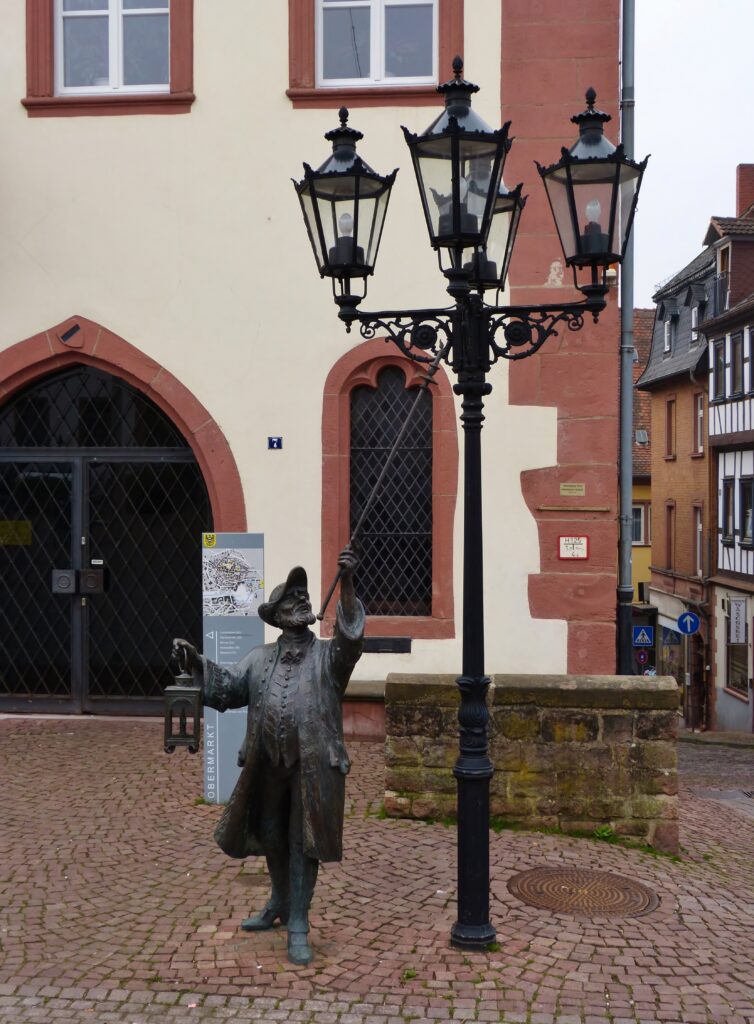
Although the street lights are now electric, the sculpture depicts a time when they were gas lamps that had to be lit by hand.
This is on an outside wall of the town hall.
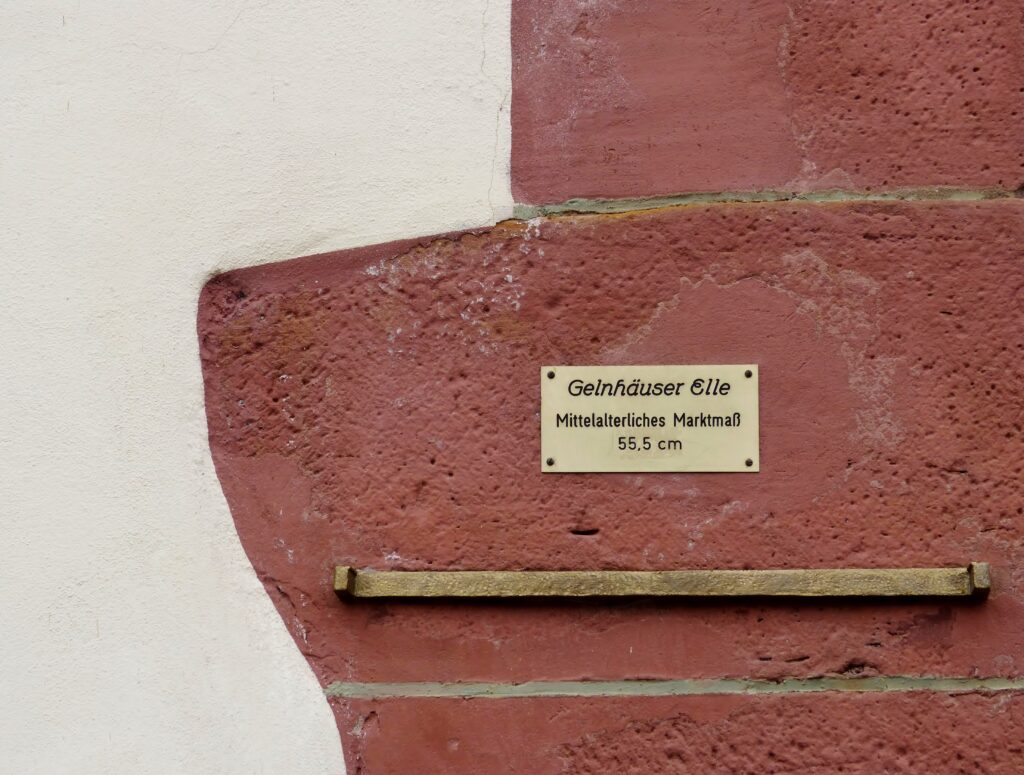
It’s a yardstick from when the building was a market hall and was used to measure goods being bought and sold.
The next stop was St. Peter’s Church.
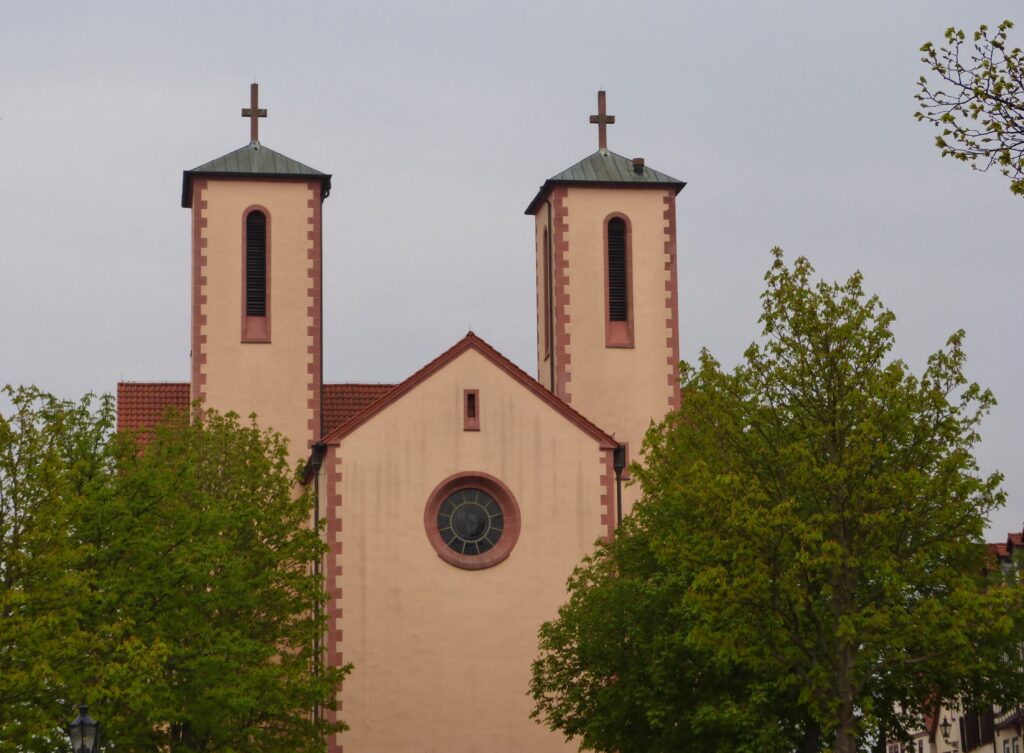
The church was begun in 1238 and construction was stopped shortly after that. In its incomplete state, the building was used for ceremonies including baptisms, weddings and funerals. It also served as a storehouse, a military hospital and a cigar factory. It was finally renovated in the early 1900s and became the Catholic parish church.
The blue half-timbered house is the birthplace of Philipp Reis.

If you’ve never heard of him, don’t feel bad. I hadn’t heard of him either but it seems he is credited with being the inventor of the telephone. And all this time I thought that honor belonged to Alexander Graham Bell. Apparently there is widespread dispute about who the actual inventor is. At least 3 other people aside from Reis and Bell are credited with the invention, although Bell was the first one to receive a patent. Reis, however, came up with his device almost 15 years before Bell came up with his. Fascinating stuff.
Next up on the walking tour was The Arnsburg Court, a Cistercian monastery.
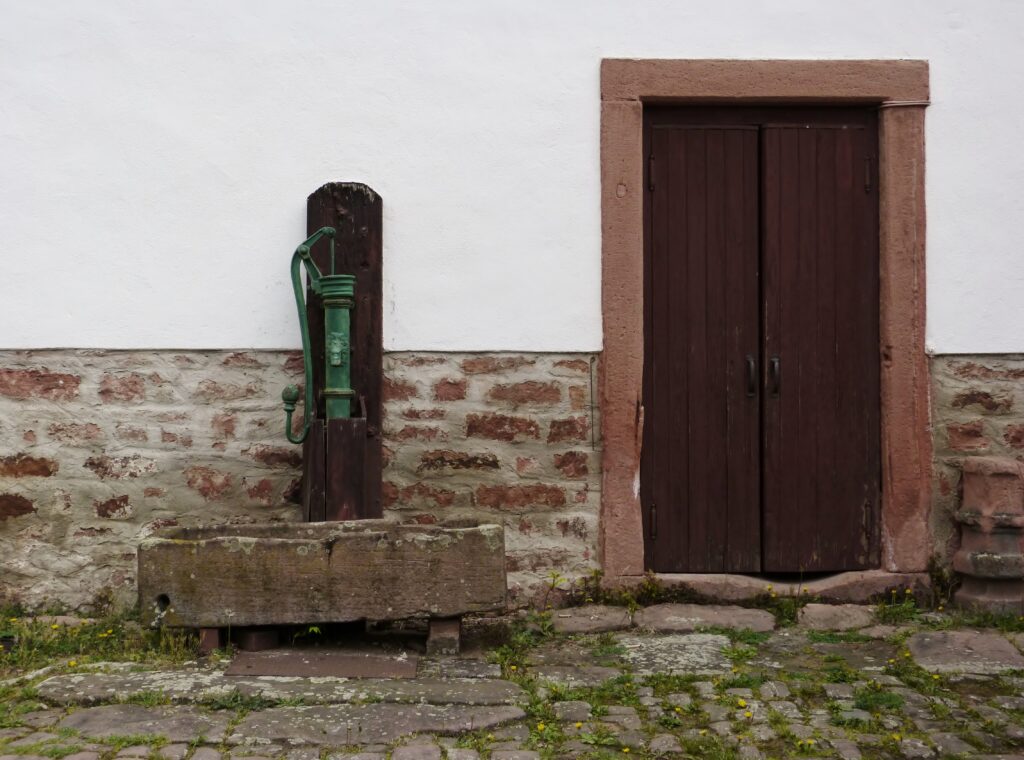
There really wasn’t anything to see there, unfortunately, but there was this cool-looking pump in the courtyard.
This building is where the Tourist Information center is housed today, along with the Municipal Library, the Town Archives and the Local History Museum.
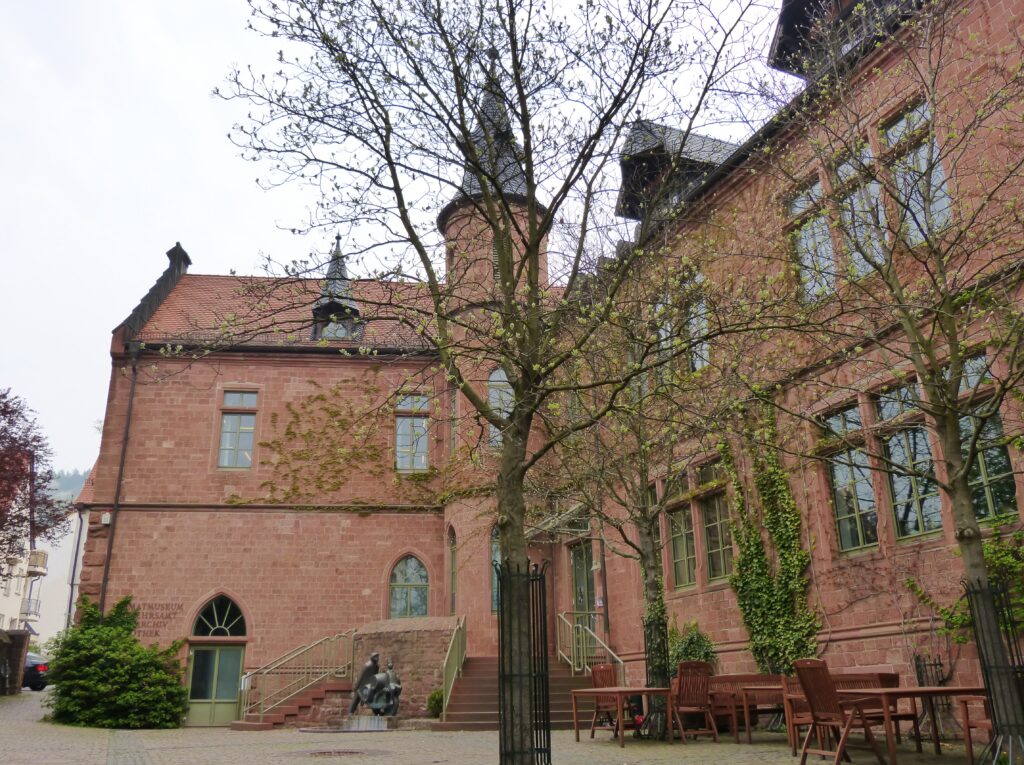
It was originally built as a Franciscan monastery at the beginning of the 13th century. It later served as a Latin school and then as a school for girls.
The Franciscan monastery complex mentioned above originally extended to where this building, around the corner from the one you just saw, stands today.

This building was erected in the 1800s and was used as a secondary school. It’s now used by local authorities.
Like the secondary school, this next building is also on the site of the Franciscan monastery.

It was built to house Gelnhausen’s first kindergarten.
This street was known as Pfarrgasse.

It was part of the old trade route between Frankfurt and Leipzig, a distance of about 250 miles. Because Pfarrgasse is so narrow, it caused a bottleneck of the horses and carts trying to make their way along the route. Due to the bottleneck, the road became the official loading point for carts in Gelnhausen.
Here you see a surviving medieval stone house.
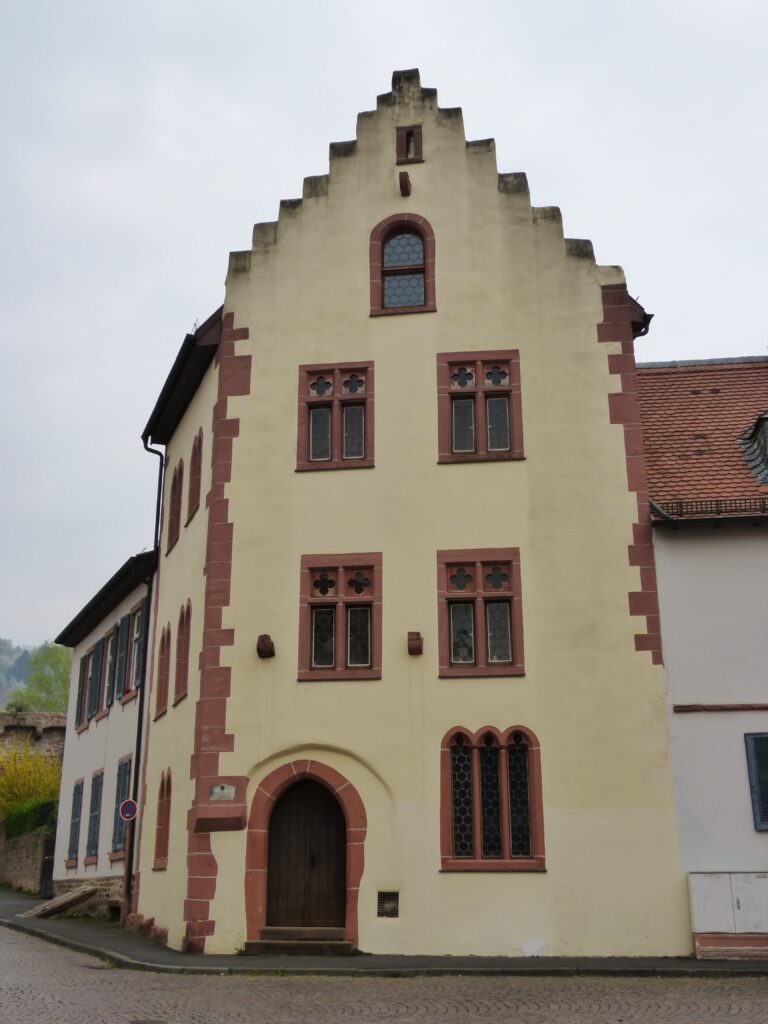
It dates from the 14th century and was known as the House of the Order of St. John of Jerusalem.
And here is another medieval stone building.
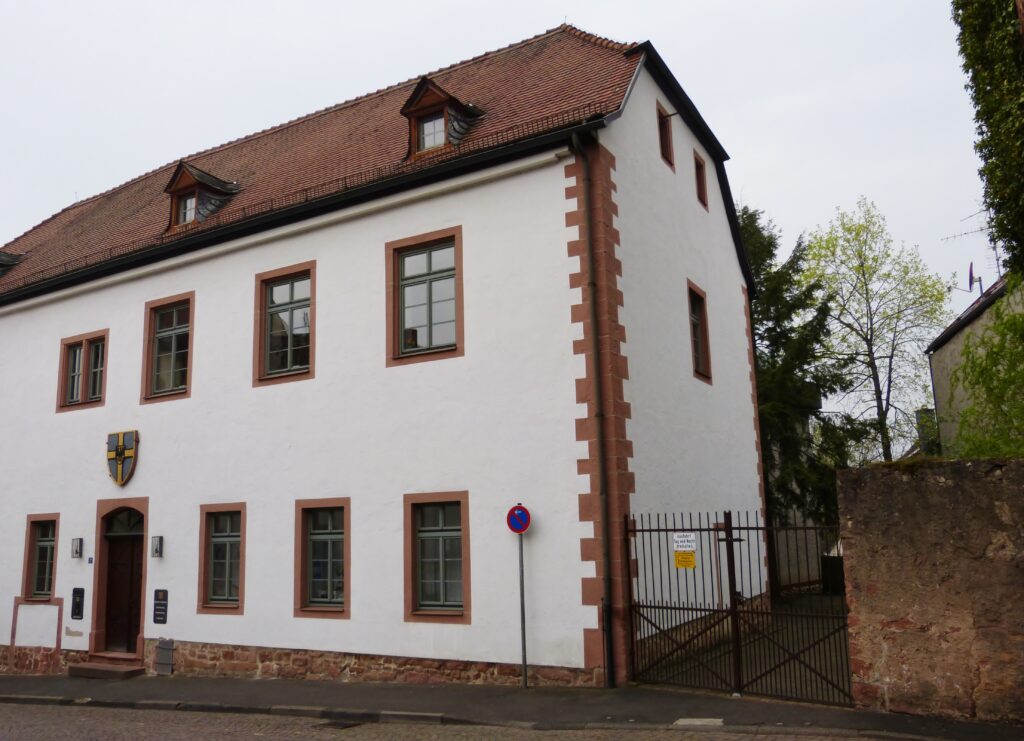
It now houses church and charitable institutions, but was originally build for the Teutonic Knights of Sachsenhausen.
This former fortification was known as the Inner Timber Gate.

It was built around 1230 and was part of the first wall built around the town.
And of course you can’t have an Inner Timber Gate without having an Outer Timber Gate!

It was part of the second, outer town wall and was built around 1330.
This tower is the oldest in Gelnhausen.

It is known as the Wine Vat Tower because its shape is similar to a basket that winegrowers wear on their backs while they’re picking grapes. The tower is now used for wedding ceremonies.
Here is another building that is also now used for wedding ceremonies.

It is a sandstone chapel from the Middle Ages and pre-dates the town’s foundations. It likely belonged to a former castle that stood above the town.
The semicircular tower here is known as the Half Moon Tower due to its shape.
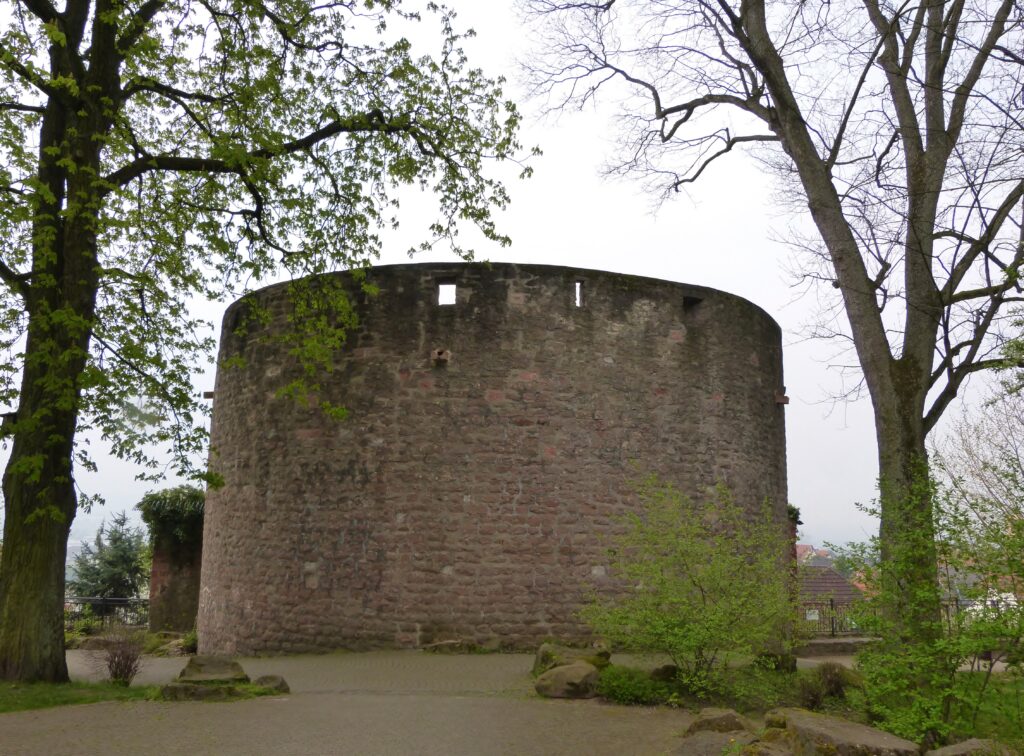
It is also from the Middle Ages. If you climb to the top of it, you get beautiful views of the town like this one.

Although you can’t go inside this building, it houses a medieval well chamber.

You can peek through the grates on the doors to see the well, though.
In the view photo above, you can see a large church to the left. It is St. Mary’s Church, built between 1170 and 1250. I was going to be nice and post a photo of the church’s rood screen with scenes from the Last Judgment, but I couldn’t do it.
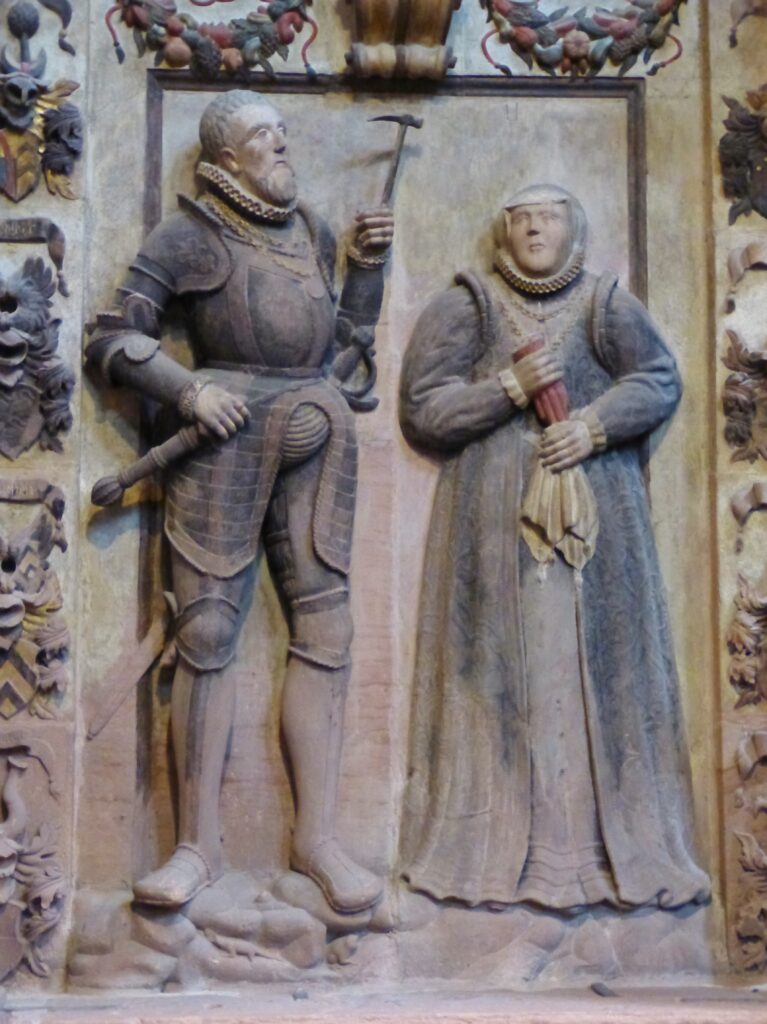
I was just too fascinated by this codpiece. I’m frankly disappointed that the codpiece ever fell out of fashion.
The 1,000-pound circular sculpture you see here, just outside St. Mary’s Church, is known as “In the Light of Elisabeth Strupp”.

Elisabeth Strupp was the widow of a clergyman and she was persecuted in 1599 for being a witch. The sculpture was erected 400 years later in 1999.
See that cute little half-timbered house behind the sculpture? It is also just outside the church and when was passed it later, one of the upper windows was open and we could hear blaring heavy metal music. It just seemed incongruous.
The building seen here is known as the Romanesque House.
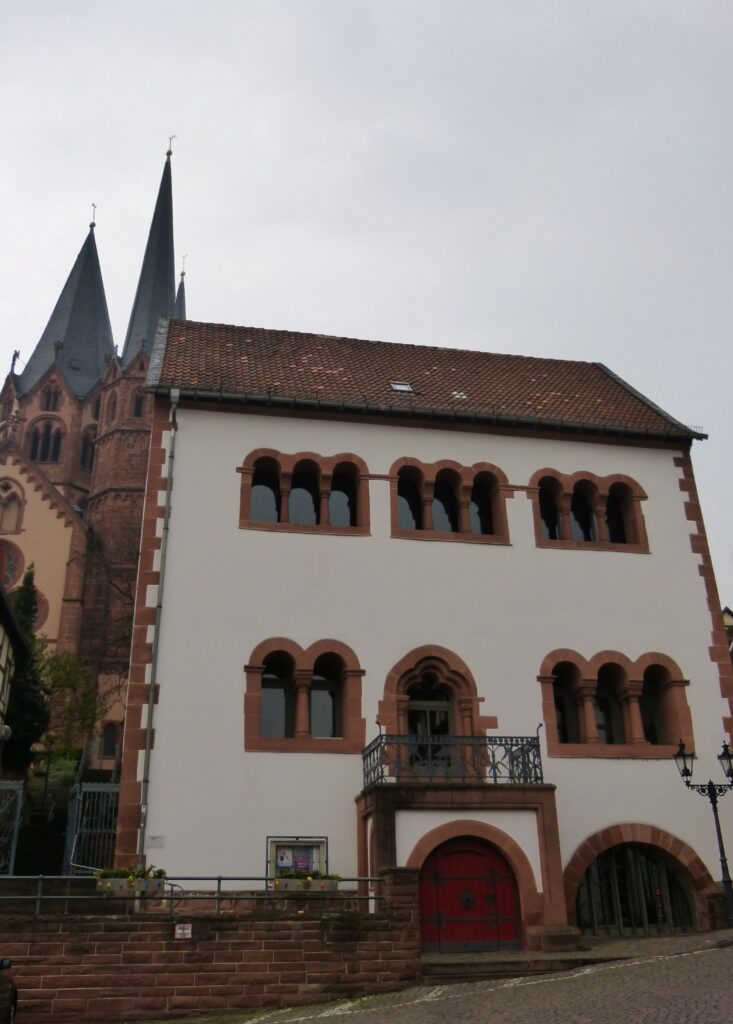
It is one of the oldest town halls in Germany. It was erected around the year 1180 and its use as an administrative building was first mentioned in 1370.
Remember Philipp Reis from earlier? The supposed inventor of the telephone? There is a bronze bust in town to memorialize him.

There I am next to the bust pretending to talk on my cell phone. I wonder what ol’ Philipp would think if he could see how far his invention has come?
Here you see another gate from the former city walls.

It is called the Haitz Gate and is the largest of the city gates. It was used up until the 19th century and was then converted into a house. See that circular thing on top of the roof? It’s some kind of air horn or something and it went off as we were walking up the road towards it. It was REALLY loud so I don’t know how anyone can stand to live in the place, but it did seem to be occupied from looking at the window decorations.
No medieval German town was complete without a Witches’ Tower.
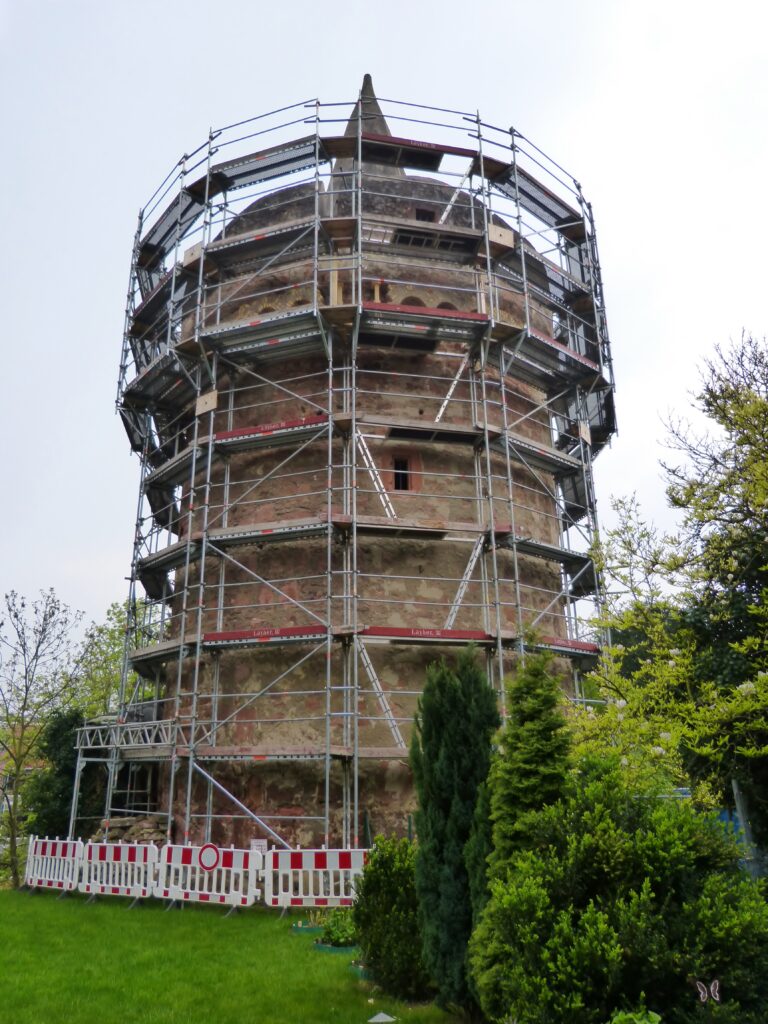
Unfortunately this one was covered in scaffolding, as you can see. The tower was originally used to store ammunition but later served as a prison during the witch trials. The top of the tower actually sort of looks like the point of a witches’ hat, doesn’t it? Apparently when the toweris not covered in scaffolding you can go in to see copies of torture instruments.
This sculpture in front of the Witches’ Tower is named “The Caller”.

It memorializes the victims of the witch trials.
This next half-timbered building, now a hotel as you can see, was the birthplace of Hans Jakob Christoffel von Grimmelshausen in 1621.
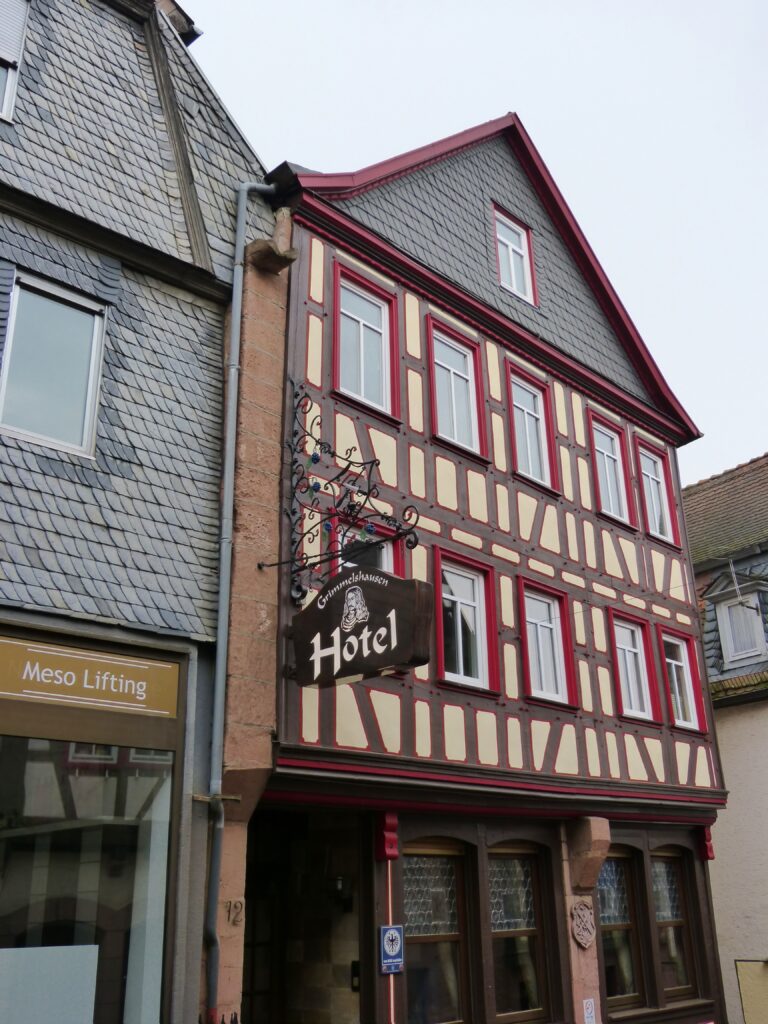
He is famous for writing a novel with a really long name that I never heard of before. It’s referred to as Simplicissimus for short, and is known as the greatest German novel of the 17th century.
The sculpture you see in the next photo is in front of the former synagogue.

The walking tour brochure describes the sculpture: “The open bronze door with three interlocking rings stands for Lessing’s “Parable of the Three Rings’ and is a symbol for the dialogue of the religions, for reconciliation and tolerance.” The synagogue was originally built in 1601 but was destroyed during the Thirty Years War. It was later rebuilt and then subsequently converted into a warehouse. Because it was used as a warehouse, the building was not destroyed by the Nazis. It was renovated again in and is now used as a “house of culture”.
Another half-timbered house!

That one is special, though. It’s from the 14th century and is one of the oldest half-timbered houses in the German state of Hesse.
And right near that house is a house built in a completely different style.

It’s called the Living Room and you can see right into all the windows. Check out the front of the house and notice the different-looking section with the 3 windows. That’s a “drawer” that is driven by a motor and can extend out almost 10 feet.
This building is called the Princes’ Court.
It’s a bit run-down looking now, but in the 16th century is was used by the Prince Electors of the Holy Roman Empire.
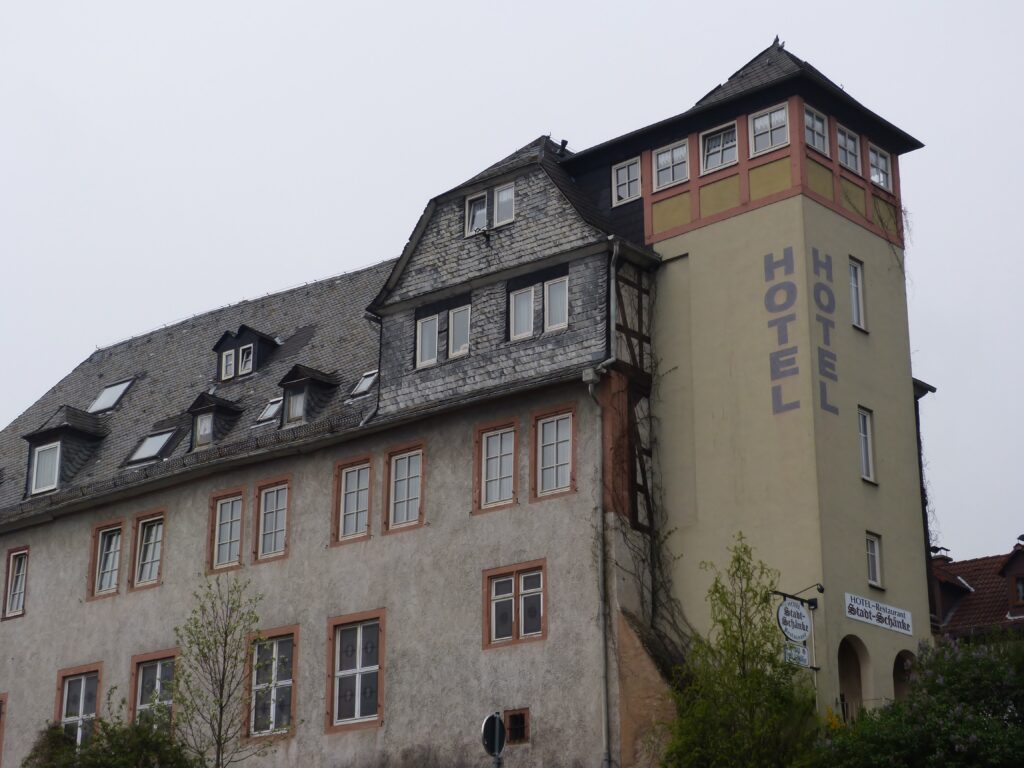
The tower you see to the right in this next photo is the Ship Gate.

At one time the river came right up to the gate and goods could be delivered here.
Here you see a section of the Jewish Cemetery.

Some of the gravestones here date back to the 1400s.
This tower looks very similar to the Ship Gate that you just saw.

It’s called the Brick Tower, though, and was part of the second city wall that you read about earlier.
For the next 4 sights, we actually drove to a different location. It is possible to walk to them, but we wanted to leave town after seeing them rather than walking back to the car, so we took the easy way out.
The next building is known as the Tithe Barn.
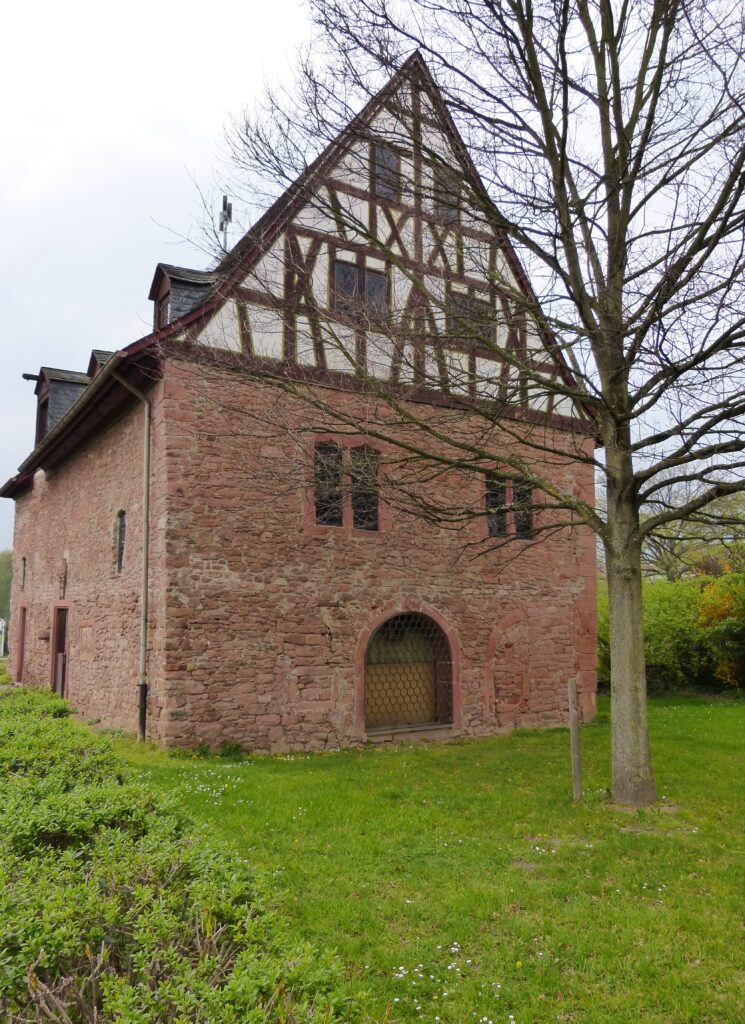
I had actually never heard of a tithe barn before, but I learned that farmers used to give one tenth of their produce to the church and the it was stored in the tithe barn.
The last gate of the tour is called Grove Gate.

It is another medieval gate and used to have living quarters for a guard above it.
In the 12th century, a palace was constructed at this site.

You can pay to visit a museum at the site, but we did not do so due to lack of time.
The last sight listed in the walking tour brochure is this “Conservatory for ideas”.

It is made of Douglas fir and the brochure describes it as a place to “rest and contemplate”.
Here is Sean contemplating.

We did see a few other sights worth mentioning even though they weren’t in the brochure.
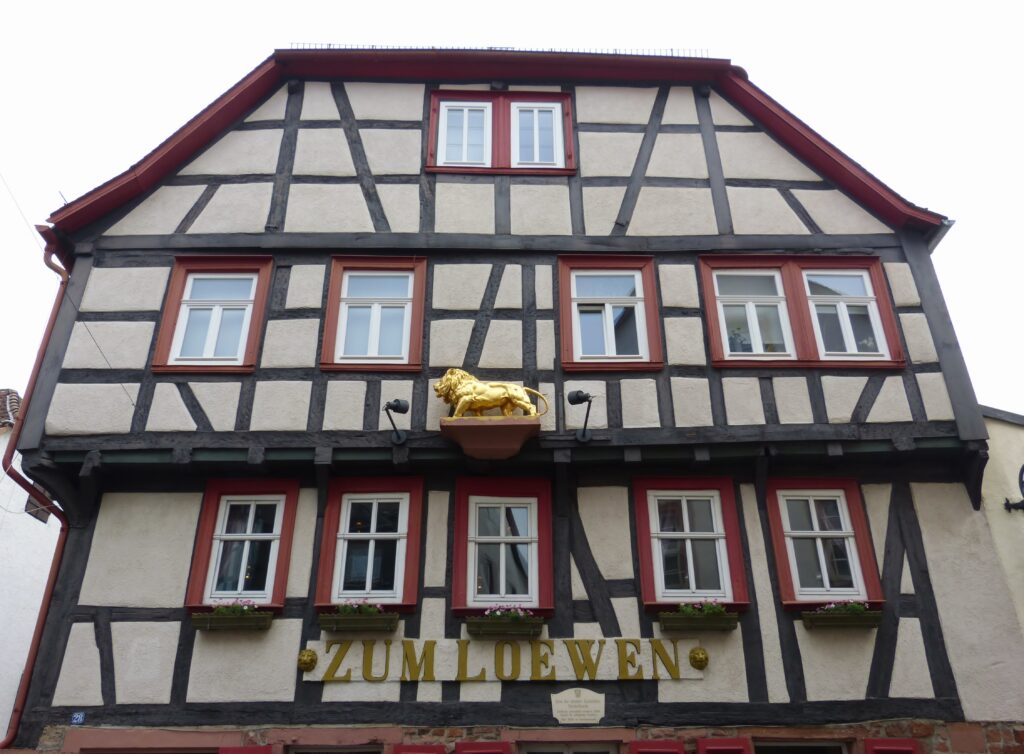
This place, called Zum Loewen, is one of the oldest restaurants in all of Germany. It was first mentioned in the year 1506 by Dr. Faustus, the man who inspired Goethe’s book Faust. It has been family owned since 1639. (Notice the golden lion on the building. Zum Loewen – also spelled as Löwen in German – means “For lions”.)
I liked this explanatory sign.
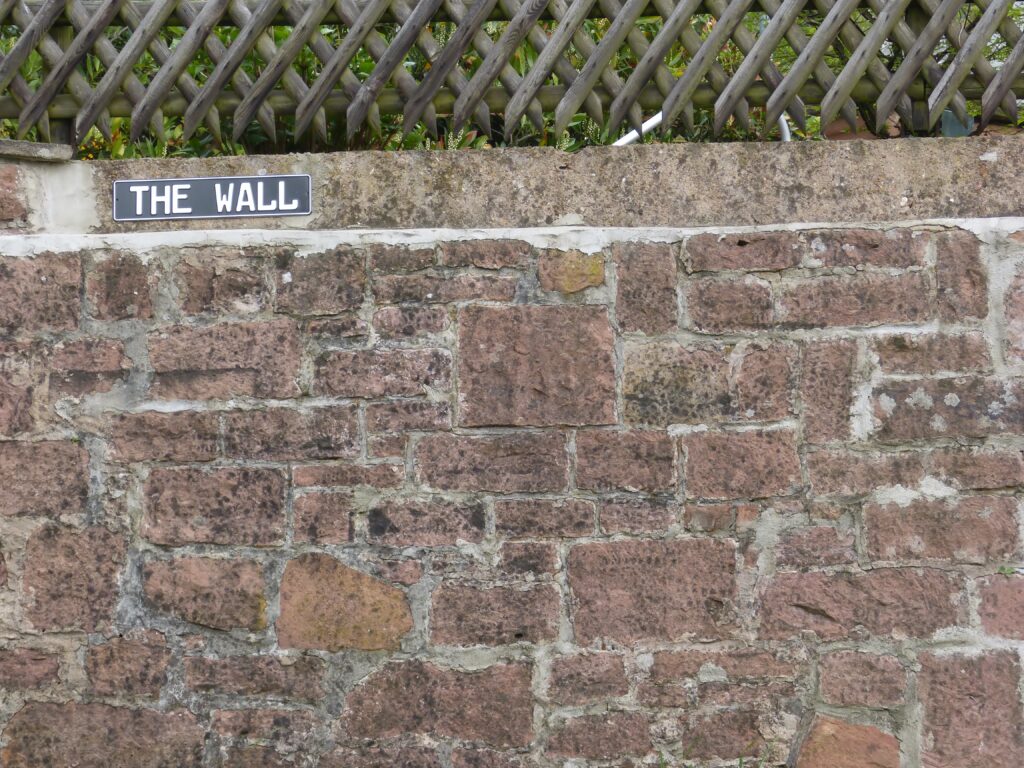
I especially liked that it was in English.
This relief of Adam and Eve was just on the outside of some building.

And right near that was this relief on the outside of some other building.
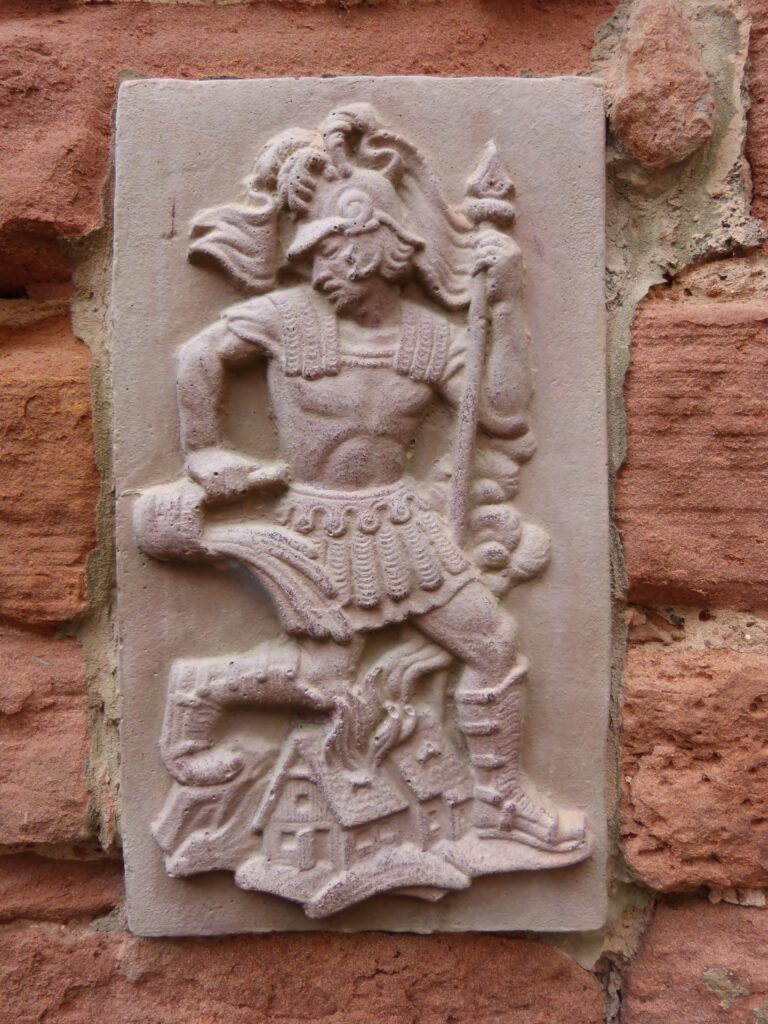
That one seems to depict a giant Roman pouring water out of a bucket to save a tiny house that’s on fire.
This plaque was outside yet another building.

It says “Barbarossastadt”, meaning Barbarossa City. Frederick Barbarossa was the Holy Roman Emperor from 1155 until he died in 1190. He founded the town and gave them trade privileges. The palace that you read about a minute ago was his palace.
If anyone knows what this is, please tell me.
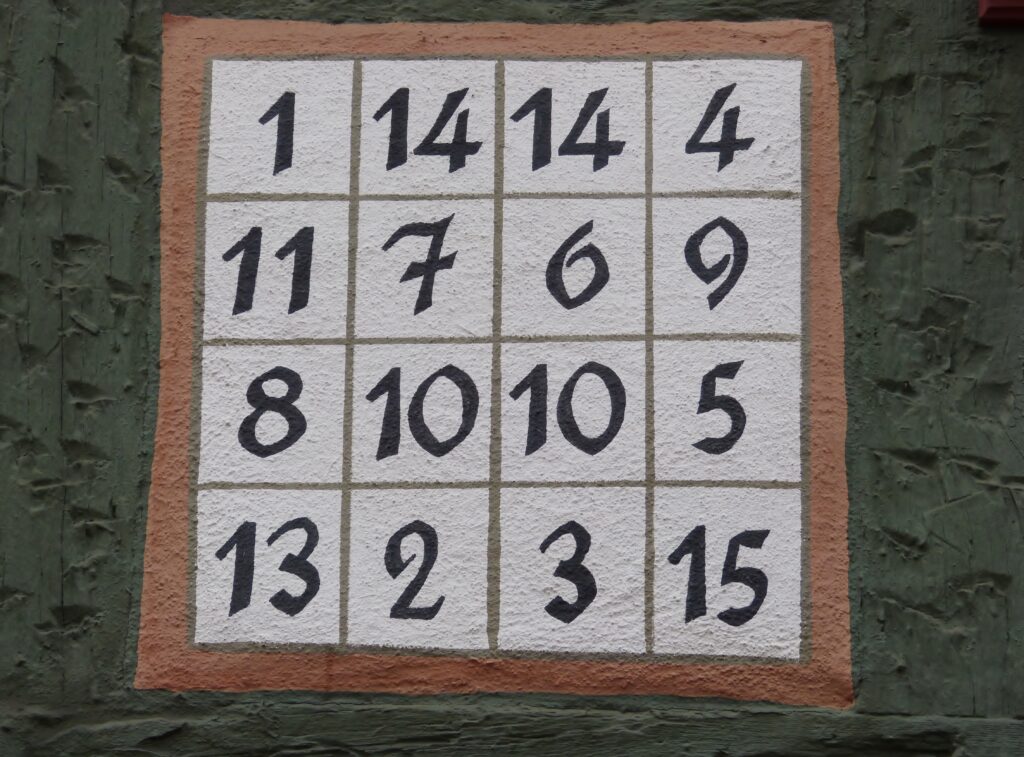
It looks like some kind of medieval Bingo or Keno board except that numbers are repeated. It was just on the outside of a building and I’d love to know what it is.
The little plaques you see here are called Stolpersteine or Stumble Stones.

Each stone commemorates either a victim or a survivor of the Holocaust. Over 1,000 cities and towns have these stones and there are over 43,000 of them in total. 8 of the 12 stones shown in this photo indicate that the victims died at the Auschwitz concentration camp in Poland.
As you may have noticed, most half-timbered houses are pretty narrow.

The above is an example of an unusually long half-timbered house.
And now for something completely different!
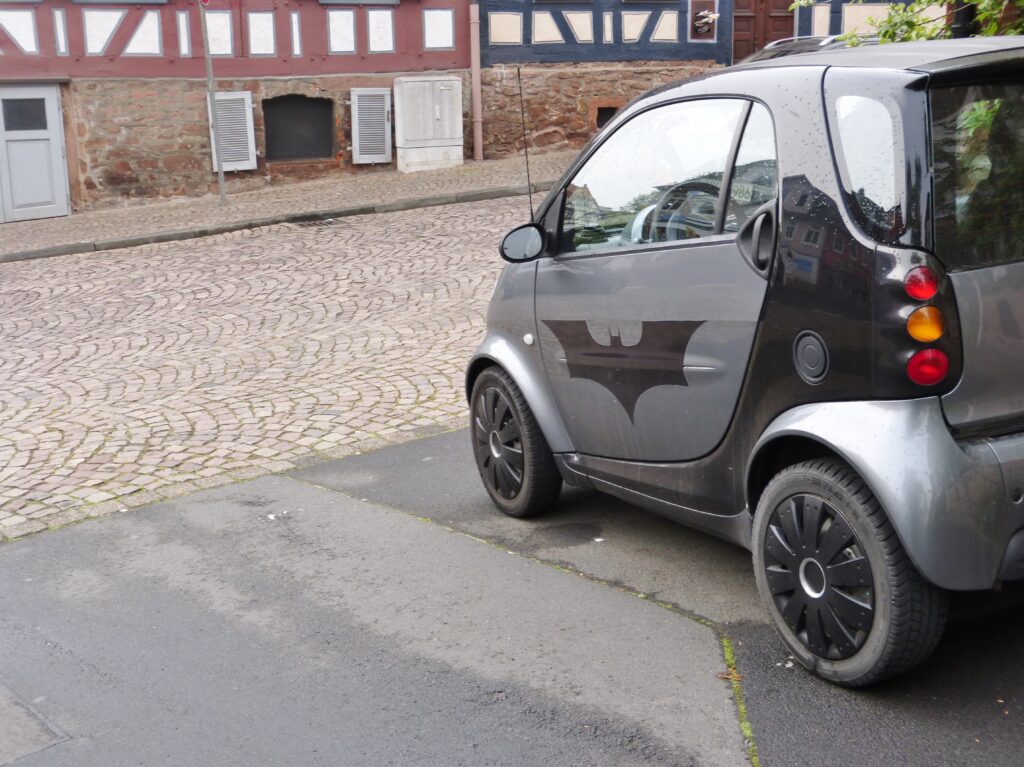
I guess times are tough and the Batmobile is now a Smartcar.
You know how you always hear that Germans love David Hasselhof?

Here’s proof that they do! Straße means street, so this is a sign for Hasselhof Street. OK, I admit I have no idea who the street is really named after, but it could be David Hasselhof, right?
Two last fun facts about Gelnhausen:
1)The U.S. Army used to have a Kaserne in the town and Colin Powell was stationed there in 1958. There is a street named after him somewhere in town, but we didn’t venture deep enough to find it.
2) The geographic center of the European Union is in a wheat field just outside of the town.
If you’ve visited Gelnhausen, feel free to share your impressions here or on our Facebook page.

